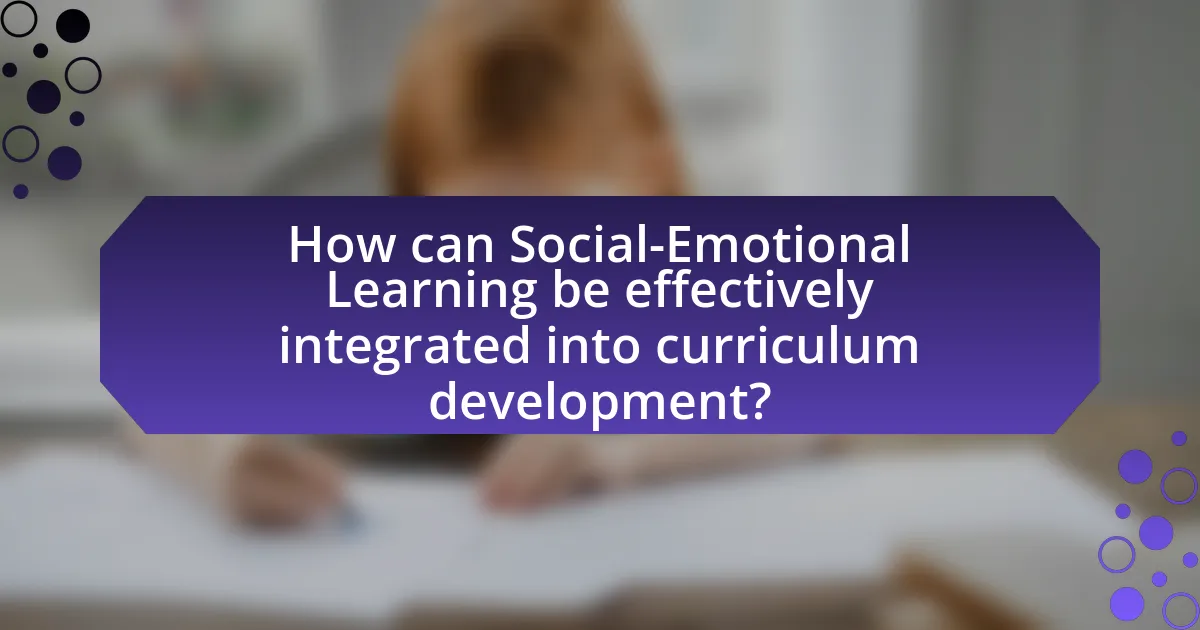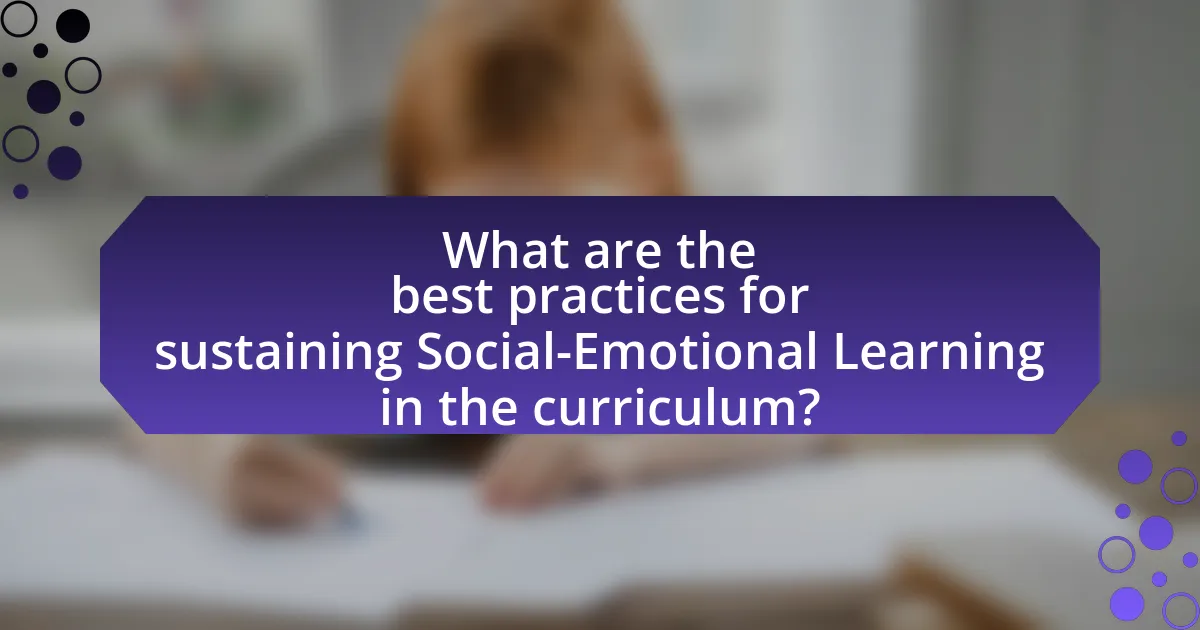Social-Emotional Learning (SEL) is a vital educational process that equips students with skills for emotional management, goal setting, empathy, relationship building, and responsible decision-making. The article emphasizes the importance of integrating SEL into curricula, highlighting its positive impact on academic performance, behavior, and school climate. Key components of SEL include self-awareness, self-management, social awareness, relationship skills, and responsible decision-making, all of which contribute to holistic student development. The article also addresses strategies for effective SEL integration, the role of assessments, challenges educators may face, and the significance of community involvement in enhancing SEL programs.

What is Social-Emotional Learning and its Importance in Education?
Social-Emotional Learning (SEL) is the process through which individuals, particularly students, develop essential skills for managing emotions, setting goals, showing empathy, maintaining positive relationships, and making responsible decisions. SEL is crucial in education as it enhances students’ academic performance, improves behavior, and fosters a positive school climate. Research from the Collaborative for Academic, Social, and Emotional Learning (CASEL) indicates that students who participate in SEL programs demonstrate an 11 percentile-point gain in academic achievement compared to those who do not. This evidence underscores the importance of integrating SEL into educational curricula to support holistic student development.
How does Social-Emotional Learning impact student development?
Social-Emotional Learning (SEL) significantly enhances student development by fostering essential skills such as emotional regulation, empathy, and interpersonal communication. Research indicates that students who engage in SEL programs demonstrate improved academic performance, better social skills, and reduced behavioral issues. For instance, a meta-analysis by Durlak et al. (2011) found that students participating in SEL initiatives showed an 11 percentile-point gain in academic achievement compared to their peers. This evidence underscores the critical role of SEL in shaping well-rounded, capable individuals who can navigate both academic and social environments effectively.
What are the key components of Social-Emotional Learning?
The key components of Social-Emotional Learning (SEL) are self-awareness, self-management, social awareness, relationship skills, and responsible decision-making. These components collectively enhance students’ ability to understand and manage their emotions, establish positive relationships, and make informed choices. Research by the Collaborative for Academic, Social, and Emotional Learning (CASEL) emphasizes that integrating these components into educational settings leads to improved academic performance and better social interactions among students.
How does Social-Emotional Learning influence academic performance?
Social-Emotional Learning (SEL) positively influences academic performance by enhancing students’ emotional intelligence, which leads to improved focus, better relationships, and increased motivation. Research indicates that students who participate in SEL programs demonstrate higher academic achievement, with a meta-analysis showing an average increase of 11 percentile points in academic performance. This improvement is attributed to SEL’s ability to foster skills such as self-regulation, empathy, and collaboration, which are essential for effective learning environments.
Why should educators incorporate Social-Emotional Learning into their curriculum?
Educators should incorporate Social-Emotional Learning (SEL) into their curriculum because it enhances students’ emotional intelligence, leading to improved academic performance and better interpersonal relationships. Research indicates that SEL programs can increase students’ academic achievement by 11 percentile points, as shown in a meta-analysis conducted by Durlak et al. (2011) in the journal “Child Development.” Additionally, SEL fosters essential skills such as empathy, self-regulation, and resilience, which are critical for success in both school and life. By integrating SEL, educators create a supportive learning environment that promotes mental well-being and prepares students for future challenges.
What are the long-term benefits of Social-Emotional Learning for students?
The long-term benefits of Social-Emotional Learning (SEL) for students include improved academic performance, enhanced emotional regulation, and better interpersonal skills. Research indicates that students who participate in SEL programs demonstrate an average increase of 11 percentile points in academic achievement compared to those who do not engage in such programs. Additionally, SEL fosters emotional intelligence, enabling students to manage their emotions effectively, which contributes to lower levels of anxiety and depression. Furthermore, SEL enhances students’ ability to collaborate and communicate, leading to stronger relationships and social skills that are essential for success in both personal and professional environments. These benefits are supported by studies such as the meta-analysis conducted by Durlak et al. (2011), which highlights the positive impact of SEL on various aspects of student development.
How does Social-Emotional Learning contribute to a positive school climate?
Social-Emotional Learning (SEL) contributes to a positive school climate by fostering emotional intelligence, enhancing relationships, and promoting a sense of belonging among students. Research indicates that schools implementing SEL programs experience reduced behavioral issues and improved academic performance, as students learn to manage their emotions and interact positively with peers. For instance, a study by Durlak et al. (2011) found that students participating in SEL programs showed an 11 percentile-point gain in academic achievement compared to those who did not. This improvement in emotional and social skills leads to a more supportive and inclusive environment, ultimately enhancing the overall school climate.

How can Social-Emotional Learning be effectively integrated into curriculum development?
Social-Emotional Learning (SEL) can be effectively integrated into curriculum development by embedding SEL competencies into academic subjects and creating a supportive school environment. This integration involves designing lessons that promote self-awareness, self-management, social awareness, relationship skills, and responsible decision-making alongside traditional academic content. Research from the Collaborative for Academic, Social, and Emotional Learning (CASEL) indicates that schools implementing SEL frameworks see improved student outcomes, including enhanced academic performance and reduced behavioral issues. By aligning SEL objectives with educational standards and providing professional development for educators, schools can ensure that SEL is a fundamental part of the learning experience.
What strategies can educators use to incorporate Social-Emotional Learning?
Educators can incorporate Social-Emotional Learning (SEL) by integrating specific practices into their curriculum, such as implementing collaborative group work, teaching emotional regulation techniques, and fostering a safe classroom environment. Collaborative group work encourages students to communicate and resolve conflicts, enhancing their social skills. Teaching emotional regulation techniques, such as mindfulness and self-reflection, helps students manage their emotions effectively. Creating a safe classroom environment, where students feel respected and valued, promotes positive relationships and emotional well-being. Research indicates that schools implementing SEL programs see improvements in student behavior and academic performance, highlighting the effectiveness of these strategies.
How can teachers design lessons that include Social-Emotional Learning objectives?
Teachers can design lessons that include Social-Emotional Learning (SEL) objectives by integrating specific SEL competencies into their lesson plans. This involves identifying key SEL skills such as self-awareness, self-management, social awareness, relationship skills, and responsible decision-making, and then creating activities that promote these skills. For example, teachers can incorporate role-playing scenarios to enhance empathy and conflict resolution, or use reflective journaling to foster self-awareness. Research indicates that SEL programs can lead to improved academic performance and better emotional regulation, as demonstrated in a meta-analysis by Durlak et al. (2011), which found that students participating in SEL programs showed an 11 percentile-point gain in academic achievement compared to their peers.
What role do assessments play in measuring Social-Emotional Learning outcomes?
Assessments play a critical role in measuring Social-Emotional Learning (SEL) outcomes by providing data that reflects students’ emotional and social competencies. These assessments can include self-reports, peer evaluations, and teacher observations, which collectively offer insights into students’ abilities to manage emotions, set goals, show empathy, and maintain relationships. Research indicates that effective SEL assessments can lead to improved academic performance and better mental health outcomes, as evidenced by a meta-analysis conducted by Durlak et al. (2011), which found that students participating in SEL programs demonstrated an 11 percentile-point gain in academic achievement compared to their peers. Thus, assessments are essential for evaluating the effectiveness of SEL initiatives and guiding curriculum development to enhance students’ overall well-being and success.
What challenges might educators face when implementing Social-Emotional Learning?
Educators may face several challenges when implementing Social-Emotional Learning (SEL), including lack of training, insufficient resources, and resistance from stakeholders. Lack of training can hinder educators’ ability to effectively teach SEL concepts, as many may not have received formal education in this area. Insufficient resources, such as time and materials, can limit the integration of SEL into existing curricula, making it difficult to prioritize these lessons alongside academic content. Additionally, resistance from parents, administrators, or the community can create obstacles, as some may not understand the importance of SEL or may have differing views on its implementation. Research indicates that these challenges can significantly impact the successful incorporation of SEL into educational settings, as highlighted in the report “The Impact of Social and Emotional Learning on Student Outcomes” by the Collaborative for Academic, Social, and Emotional Learning (CASEL).
How can schools overcome resistance to integrating Social-Emotional Learning?
Schools can overcome resistance to integrating Social-Emotional Learning (SEL) by providing comprehensive training for educators and involving parents in the process. Research indicates that when teachers receive targeted professional development on SEL, they are more likely to implement these practices effectively, leading to improved student outcomes. For instance, a study by Durlak et al. (2011) found that SEL programs can enhance students’ social skills and academic performance when educators are well-prepared. Additionally, engaging parents through workshops and informational sessions can foster a supportive community that values SEL, thereby reducing resistance. This collaborative approach ensures that all stakeholders understand the benefits of SEL, creating a more conducive environment for its integration into the curriculum.
What resources are available to support educators in this process?
Educators can access various resources to support the incorporation of social-emotional learning (SEL) into curriculum development. These resources include organizations such as the Collaborative for Academic, Social, and Emotional Learning (CASEL), which provides frameworks, tools, and research-based practices for implementing SEL in educational settings. Additionally, the National Center for Mental Health Promotion and Youth Violence Prevention offers training and materials focused on integrating SEL into existing curricula. Research studies, such as those published in the Journal of Educational Psychology, demonstrate that effective SEL programs lead to improved student outcomes, reinforcing the importance of these resources for educators.

What are the best practices for sustaining Social-Emotional Learning in the curriculum?
The best practices for sustaining Social-Emotional Learning (SEL) in the curriculum include integrating SEL into daily instruction, providing ongoing professional development for educators, and fostering a supportive school climate. Integrating SEL into daily instruction ensures that emotional and social skills are taught alongside academic content, which has been shown to improve student outcomes. Ongoing professional development equips educators with the necessary tools and strategies to effectively teach and model SEL competencies. Additionally, fostering a supportive school climate, characterized by positive relationships and a sense of belonging, enhances students’ emotional well-being and engagement. Research indicates that schools implementing these practices see significant improvements in student behavior and academic performance, as highlighted in the Collaborative for Academic, Social, and Emotional Learning (CASEL) framework.
How can schools ensure ongoing support for Social-Emotional Learning initiatives?
Schools can ensure ongoing support for Social-Emotional Learning (SEL) initiatives by integrating SEL into the curriculum and providing continuous professional development for educators. By embedding SEL into daily lessons and activities, schools create a consistent environment that prioritizes emotional and social skills alongside academic learning. Research from the Collaborative for Academic, Social, and Emotional Learning (CASEL) indicates that schools implementing comprehensive SEL programs see improved student outcomes, including better academic performance and reduced behavioral issues. Additionally, ongoing training for teachers equips them with the necessary tools and strategies to effectively teach and model SEL, fostering a supportive school culture that values emotional well-being.
What professional development opportunities are essential for educators?
Essential professional development opportunities for educators include training in social-emotional learning (SEL), workshops on culturally responsive teaching, and collaborative learning communities. Research indicates that SEL training enhances educators’ ability to foster supportive classroom environments, which is crucial for student engagement and academic success. According to the Collaborative for Academic, Social, and Emotional Learning (CASEL), effective SEL programs lead to improved student outcomes, including better academic performance and reduced behavioral issues. Additionally, culturally responsive teaching workshops equip educators with strategies to address diverse student needs, promoting inclusivity and equity in the classroom. Collaborative learning communities provide ongoing support and shared resources, facilitating continuous improvement in teaching practices.
How can community involvement enhance Social-Emotional Learning programs?
Community involvement can enhance Social-Emotional Learning (SEL) programs by providing real-world contexts and support systems that reinforce emotional and social skills. Engaging families, local organizations, and community leaders in SEL initiatives fosters a collaborative environment where students can practice these skills outside the classroom. Research indicates that schools with strong community partnerships report improved student behavior and academic performance, as seen in a study by the Collaborative for Academic, Social, and Emotional Learning (CASEL), which highlights that community engagement leads to more effective SEL implementation. This involvement not only enriches the learning experience but also creates a network of support that is crucial for the emotional well-being of students.
What practical tips can educators apply to enhance Social-Emotional Learning in their classrooms?
Educators can enhance Social-Emotional Learning (SEL) in their classrooms by integrating structured SEL programs into the curriculum. Research indicates that programs like the Collaborative for Academic, Social, and Emotional Learning (CASEL) framework improve students’ emotional skills and academic performance. Additionally, educators should create a safe and inclusive classroom environment that encourages open communication and emotional expression, as studies show that supportive environments foster better social-emotional development. Implementing regular check-ins or reflection activities allows students to articulate their feelings and experiences, which is crucial for developing self-awareness and empathy. Finally, incorporating cooperative learning activities promotes teamwork and relationship-building, essential components of SEL.
How can teachers create a safe and supportive environment for Social-Emotional Learning?
Teachers can create a safe and supportive environment for Social-Emotional Learning by establishing clear expectations, fostering open communication, and promoting inclusivity. Clear expectations help students understand behavioral norms, which can reduce anxiety and create a sense of security. Open communication encourages students to express their feelings and concerns, facilitating emotional expression and connection. Promoting inclusivity ensures that all students feel valued and respected, which is essential for emotional safety. Research indicates that classrooms with supportive environments lead to improved student engagement and emotional well-being, as highlighted in the Collaborative for Academic, Social, and Emotional Learning (CASEL) framework.
What activities can promote Social-Emotional Learning among students?
Activities that can promote Social-Emotional Learning (SEL) among students include collaborative group projects, role-playing exercises, and mindfulness practices. Collaborative group projects encourage teamwork and communication, allowing students to develop interpersonal skills and empathy. Role-playing exercises provide opportunities for students to explore different perspectives and practice conflict resolution, enhancing their emotional understanding. Mindfulness practices, such as guided meditation or breathing exercises, help students manage stress and improve focus, contributing to their emotional regulation. Research indicates that implementing these activities can lead to improved social skills and emotional well-being in students, as evidenced by studies showing that SEL programs can increase positive behaviors and decrease emotional distress.



